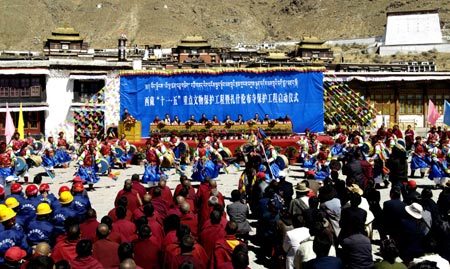China on Friday launched a 570 million yuan (US$81.43 million) project to preserve 22 historical and cultural relics in the southwestern Tibet Autonomous Region.

The launching ceremony of a five-year Tibet Autonomous Region key cultural relics protection project and the Tashilumpo Monastery protection project is held at the Tashilumpo Monastery in Xigaze of southwest China's Tibet Autonomous Region on April 18, 2008. The region's overall protection project covers 22 key cultural relics at a planned cost of 570 million yuan (US$81 million), nearly 200 million yuan (US$28 million) more than the previous five-year protection project.
The project, China's largest protection move in the region, will last until 2010. It included 15 monasteries under state-level protection and seven historical sites proving the rule over Tibet by central governments through history, said Yudawa, the Tibet Autonomous Regional Cultural Heritage Bureau director.
The preservation efforts were financed by the National Development and Reform Commission and the Ministry of Finance.
Of the funds, 118 million yuan will go to the preservation of the 237,000-square-meter Zhaxi Lhunbo Lamasery in Xigaze. It consists of a main palace and six minor ones, 56 sutra halls, and more than 6,000 rooms for monks. It was built in 1447 and was the traditional residence of Panchen Lamas.
It is expected to take workers up to four years to seal cracks on the walls, fix windows and doors, repair water discharge channels, replace worn out electrical wires and install firefighting and lightning-proof facilities in the lamasery, the second largest cultural relic after the Potala Palace in Tibet.
Also included is 50 million yuan to be used for the preservation of the Jokhang, Ramogia, Sanyai and Samgya-Goutog monasteries. The restoration will start this year after the construction tenders are decided.
The latest move to protect Tibet's cultural and religious relics comes after a 330 million yuan preservation project on the Potala Palace, Sagya Monastery and Norbu Lingka Palace. These began in 2002 and were expected to be finished this year.
Over the past two decades, China has invested more than 700 million yuan to preserve and maintain more than 1,400 monasteries, cultural relics and religious sites, Yudawa said.
"These projects have protected Tibet's historical and cultural relics effectively."

Performers dance at the launching ceremony of a five-year Tibet Autonomous Region key cultural relics protection project and the Tashilumpo Monastery protection project held at the Tashilumpo Monastery in Xigaze of southwest China's Tibet Autonomous Region on April 18, 2008.

A lama smiles while attending the launching ceremony of a five-year Tibet Autonomous Region key cultural relics protection project and the Tashilumpo Monastery protection project held at the Tashilumpo Monastery in Xigaze of southwest China's Tibet Autonomous Region on April 18, 2008.
(Xinhua News Agency April 19, 2008)